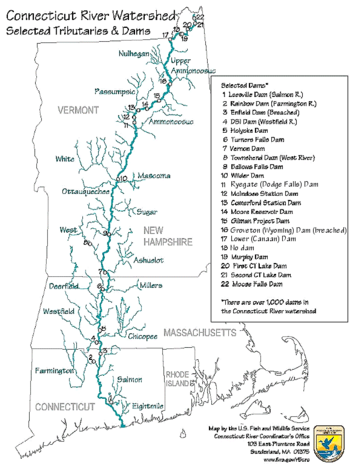Connecticut River: Difference between revisions
Pat Palmer (talk | contribs) mNo edit summary |
Pat Palmer (talk | contribs) mNo edit summary |
||
| Line 1: | Line 1: | ||
{{subpages}} | |||
{{Image|Connecticut River Map.png|right|350px|The Connecticut River flows through the U.S. states of New Hampshire, Vermont, Massachussetts and Connecticut.}} | {{Image|Connecticut River Map.png|right|350px|The Connecticut River flows through the U.S. states of New Hampshire, Vermont, Massachussetts and Connecticut.}} | ||
The '''Connecticut River''' is the longest river in the [[New England]] region of the [[United States of America|U.S.]], flowing roughly southward for 406 miles through several U.S. states. It rises 300 yards (270 m) south of the U.S. border with [[Quebec]], [[Canada]], and discharges at [[Long Island Sound]].<ref>{{cite web| url=https://www.bbc.co.uk/essex/features/essex_around_world/essex_connecticut.shtml| author=Linda Brughelli| title=Essex - Connecticut| work=BBC Local: Essex| date=October 28, 2014| access-date=August 9, 2016| archive-url=https://web.archive.org/web/20161020064052/http://www.bbc.co.uk/essex/features/essex_around_world/essex_connecticut.shtml| archive-date=October 20, 2016| url-status=live}}</ref> Its watershed encompasses 11,260 square miles, covering parts of five U.S. states and one Canadian province, via 148 tributaries, 38 of which are major rivers.<ref name="ctriver.org">{{cite web| url=http://www.ctriver.org/river-resources/about-our-rivers/watershed-facts/| title=Watershed Facts| publisher=Connecticut River Watershed Council| access-date=August 9, 2016| archive-url=https://web.archive.org/web/20160805023222/http://www.ctriver.org/river-resources/about-our-rivers/watershed-facts/| archive-date=August 5, 2016| url-status=live}}</ref> It produces 70% of Long Island Sound's fresh water,<ref name="ctriver.org"/> discharging at 18,400 cubic feet per second.<ref>{{Cite web|title=USGS Water-Year Summary for Site 01184000|url=https://waterdata.usgs.gov/nwis/annual?referred_module=sw&site_no=01184000&por_01184000_64671=1269463,00060,64671,1928,2020&start_dt=1978&end_dt=2016&year_type=W&format=html_table&date_format=YYYY-MM-DD&rdb_compression=file&submitted_form=parameter_selection_list |access-date=January 12, 2021 |website=waterdata.usgs.gov |archive-date=February 27, 2021 |archive-url=https://web.archive.org/web/20210227164725/https://waterdata.usgs.gov/nwis/annual?referred_module=sw&site_no=01184000&por_01184000_64671=1269463,00060,64671,1928,2020&start_dt=1978&end_dt=2016&year_type=W&format=html_table&date_format=YYYY-MM-DD&rdb_compression=file&submitted_form=parameter_selection_list |url-status=live}}</ref> | The '''Connecticut River''' is the longest river in the [[New England]] region of the [[United States of America|U.S.]], flowing roughly southward for 406 miles through several U.S. states. It rises 300 yards (270 m) south of the U.S. border with [[Quebec]], [[Canada]], and discharges at [[Long Island Sound]].<ref>{{cite web| url=https://www.bbc.co.uk/essex/features/essex_around_world/essex_connecticut.shtml| author=Linda Brughelli| title=Essex - Connecticut| work=BBC Local: Essex| date=October 28, 2014| access-date=August 9, 2016| archive-url=https://web.archive.org/web/20161020064052/http://www.bbc.co.uk/essex/features/essex_around_world/essex_connecticut.shtml| archive-date=October 20, 2016| url-status=live}}</ref> Its watershed encompasses 11,260 square miles, covering parts of five U.S. states and one Canadian province, via 148 tributaries, 38 of which are major rivers.<ref name="ctriver.org">{{cite web| url=http://www.ctriver.org/river-resources/about-our-rivers/watershed-facts/| title=Watershed Facts| publisher=Connecticut River Watershed Council| access-date=August 9, 2016| archive-url=https://web.archive.org/web/20160805023222/http://www.ctriver.org/river-resources/about-our-rivers/watershed-facts/| archive-date=August 5, 2016| url-status=live}}</ref> It produces 70% of Long Island Sound's fresh water,<ref name="ctriver.org"/> discharging at 18,400 cubic feet per second.<ref>{{Cite web|title=USGS Water-Year Summary for Site 01184000|url=https://waterdata.usgs.gov/nwis/annual?referred_module=sw&site_no=01184000&por_01184000_64671=1269463,00060,64671,1928,2020&start_dt=1978&end_dt=2016&year_type=W&format=html_table&date_format=YYYY-MM-DD&rdb_compression=file&submitted_form=parameter_selection_list |access-date=January 12, 2021 |website=waterdata.usgs.gov |archive-date=February 27, 2021 |archive-url=https://web.archive.org/web/20210227164725/https://waterdata.usgs.gov/nwis/annual?referred_module=sw&site_no=01184000&por_01184000_64671=1269463,00060,64671,1928,2020&start_dt=1978&end_dt=2016&year_type=W&format=html_table&date_format=YYYY-MM-DD&rdb_compression=file&submitted_form=parameter_selection_list |url-status=live}}</ref> | ||
The Connecticut River Valley is home to some of the northeastern United States' most productive farmland, as well as the [[Hartford–Springfield|Hartford–Springfield Knowledge Corridor]], a metropolitan region of approximately two million people surrounding [[Springfield, Massachusetts]], and [[Hartford, Connecticut]].<ref name="connecticutriver.us">{{cite web| url=http://connecticutriver.us/site/content/about-river| title=About the River| website=Connecticutriver.us| access-date=August 9, 2016| archive-url=https://web.archive.org/web/20160815051454/http://connecticutriver.us/site/content/about-river| archive-date=August 15, 2016| url-status=live}}</ref> | The Connecticut River Valley is home to some of the northeastern United States' most productive farmland, as well as the [[Hartford–Springfield|Hartford–Springfield Knowledge Corridor]], a metropolitan region of approximately two million people surrounding [[Springfield, Massachusetts]], and [[Hartford, Connecticut]].<ref name="connecticutriver.us">{{cite web| url=http://connecticutriver.us/site/content/about-river| title=About the River| website=Connecticutriver.us| access-date=August 9, 2016| archive-url=https://web.archive.org/web/20160815051454/http://connecticutriver.us/site/content/about-river| archive-date=August 15, 2016| url-status=live}}</ref> | ||
==Notes== | |||
<references> | |||
</references> | |||
Revision as of 10:42, 6 August 2023
The Connecticut River is the longest river in the New England region of the U.S., flowing roughly southward for 406 miles through several U.S. states. It rises 300 yards (270 m) south of the U.S. border with Quebec, Canada, and discharges at Long Island Sound.[1] Its watershed encompasses 11,260 square miles, covering parts of five U.S. states and one Canadian province, via 148 tributaries, 38 of which are major rivers.[2] It produces 70% of Long Island Sound's fresh water,[2] discharging at 18,400 cubic feet per second.[3]
The Connecticut River Valley is home to some of the northeastern United States' most productive farmland, as well as the Hartford–Springfield Knowledge Corridor, a metropolitan region of approximately two million people surrounding Springfield, Massachusetts, and Hartford, Connecticut.[4]
Notes
- ↑ Linda Brughelli (October 28, 2014). Essex - Connecticut. BBC Local: Essex.
- ↑ 2.0 2.1 Watershed Facts. Connecticut River Watershed Council.
- ↑ USGS Water-Year Summary for Site 01184000.
- ↑ About the River.
